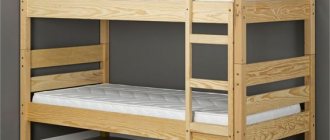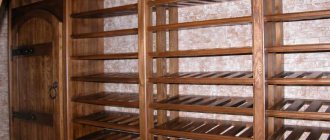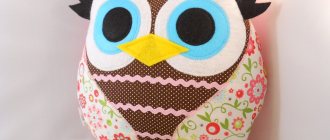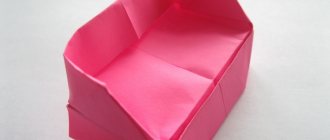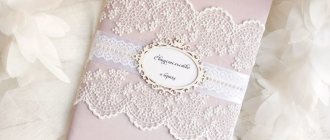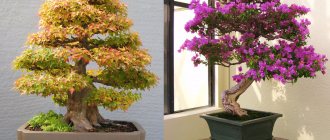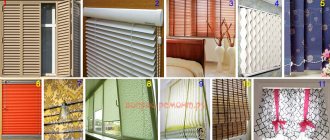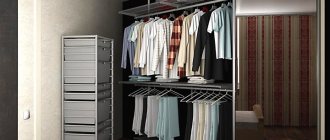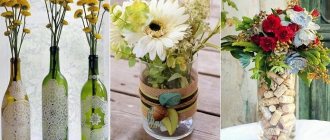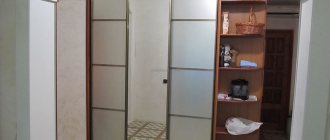A DIY shelving unit is not only simple, but also economical. If you have never made something with your own hands before, then a whatnot is the first step for a novice craftsman.
What is a bookcase? This is a furniture option that consists of shelves combined into a common structure. The shelf can be used for flowers, shoes, personal care products or tools.
There are no restrictions on the use of shelves, except for weighing ones. You should not load the bookcase with too much weight, because it is not a rack.
A bookcase, as you know, is a cabinet without walls.
Long gone are the days when the whatnot was the “highlight” of the living room and the hostesses of secular salons vying with each other to see whose was cooler.
The benefits of making it yourself
Do you know what the advantages of any “hand-made” product are?
- Savings in its purest form. Often, when buying a finished item, you have to overpay for the brand name, for low-quality material purchased in bulk, and for the work of the craftsman.
- Meets all requirements. You make a bookcase according to certain technical characteristics: width, height, number of shelves, material, color. Of course, stores offer a huge variety of options for any furniture. The bookcases were no exception. But most often, products produced on a machine are measured in whole units. You can make an interior item that is ideal in size and style.
You can name other advantages to making a bookcase with your own hands, but all the main ones are highlighted.
It is also shelves height from the floor, sometimes on wheels, or a rack for a relatively small operational load, not attached to the floor, walls or ceiling.
Nowadays, most of the shelves in everyday life are used to place indoor plants.
Setting up the kitchen
It happens that in the kitchen there is a narrow space between pieces of furniture, which spoils the appearance and seems to be unsuitable for use. We offer you a master class on how to make a roll-out shelf.
You need to prepare:
- boards, according to the number of shelves you plan to make;
- slats;
- furniture wheels;
- handle for easy rolling out;
- wooden slab;
- screws and dowels;
- glue.
We measure the space that we want to fill with a shelf, and accordingly decide on the width of the shelf. We cut the necessary parts.
We begin to attach the shelves to a wooden slab, which will serve as the back wall of the product. Before assembly, coat the joints of the parts with glue, and only then connect them with screws.
We screwed the shelves, now we fix the sides.
You can press it with a weight for better adhesion of the glue.
The base is ready.
Now we glue the slats that will prevent the contents of the shelf from falling from it.
Screw on the wheels and handle. We install the shelf in the opening.
The roll-out shelf is ready. And the empty space has been filled, and additional storage spaces have appeared.
Deciding on design and construction
The design of the bookcase depends entirely on your desires and capabilities. If we are talking about a bookcase as a decorative element, then you can choose an interesting material: rattan or glass, beech or forged metal.
A multifunctional piece of cabinet furniture that can effectively zone a room and be aesthetically significant in the interior.
Here the openwork of the whatnot works for functionality: using the whatnot, plants can be placed on a minimal floor area so that they do not shade each other and it is convenient for the owner to care for them.
Naturally, only a true master who knows how to work with this or that material and has the necessary tools can do this with his own hands.
You can make a bookcase from any more or less durable and workable material, but novice furniture makers should not get carried away with their variety.
For the same purpose, special shelves for flowers are built, but they are, as a rule, stationary, attached to some kind of base, and the shelf is adjustable.
Speaking of practical applications, making a bookcase with your own hands is quite simple. The design consists of two vertical bases and horizontal shelves between them. There are an incredible variety of mounting options and they depend on the material of manufacture.
- The easiest way is to screw the shelves to the base from the outside. This assembly method is relevant for wooden shelves. If you think that it will not be beautiful, then we can reassure you, there are plugs for self-tapping screws in different colors.
- Each shelf has holes in the corners; posts are inserted into these holes to separate the shelves from each other. Most often, this design is offered for plastic shelves for bathtubs or shoes. But glass shelves can also be organized in a similar way. Dividing posts can be chrome plated. Although metal can also be assembled into a bookcase in a similar way.
- The variety of fittings allows you to choose fastening elements hidden in the body of the product.
Shelves assembled using hidden mortise carpentry joints are rarely made independently, and are expensive to sell.
Even today, a shelf can become a key element of interior design.
These are the main examples of whatnot design. You can improvise or use decor. Thus, forged elements can give the simplest and most inexpensive wooden product not only charm, but also luxury.
The most durable is a wooden shelf assembled with an overlay.
Well-made rustic furniture looks amazing and fits into almost any interior, down to the loft.
Shelving options
There are different variations of shelving. The difference lies not only in design features. The materials used and their combinations may be different. In each case, there are subtleties of work that are better to find out in advance.
Wood
It’s not difficult to make a wooden rack yourself. For work you will need supports, bars and boards. To secure the structure, metal corners, clusters, and screws are needed. To process the structure you will need impregnation, varnish or paint. The work progress is as follows:
- To begin with, the parts are prepared. If the size of the purchased building materials is larger than required for the intended design, then the dimensions are adjusted by trimming.
- Elements ready for assembly are pre-processed. To do this you will need special impregnation, varnish or paint. The parts are dried before further fastening together.
- At the location of future shelves, metal corners are screwed to the vertical beams. Horizontal supports are attached to them. After this, the installation of the shelf begins. All this is first done with the bottom shelf. By analogy, all remaining tiers of the rack are made.
This is an option for manufacturing the simplest design. It will be more difficult to make a rack with side walls, as well as more complex products. If necessary, anyone can find a diagram, drawings and a detailed description of the work process.
From pipes
The work usually uses various pipe remnants that are at hand. These can be ordinary round variations, but it is better to opt for profiled specimens.
Chrome-plated pipes are preferable for home shelving; in other cases, you can get by with what you have in stock.
You can use different materials for shelves. Most often it is plywood or boards.
Fittings, angles, and tees are used to connect parts. Flanges are used as wall mounting and legs. Working with metal is more difficult. This requires special knowledge and tools. The structure is assembled according to the diagram.
From profile
To make the racks, a metal profile is used from standard galvanized elements made of material with a thickness of at least 0.5 mm.
Characteristics are selected based on the loads to which the structure will be subjected.
Self-tapping screws with a press washer are used as fasteners. They press well to the metal surface. For shelves you will need plywood, board or OSB. Before starting work, be sure to make a drawing, which will become a guide in the process of assembling the structure.
From boards
Before starting to assemble a rack from boards, a drawing is made, as well as materials are prepared. When the cut to the required dimensions is completed, marks are placed on the boards of the side parts for future shelves. At these places, corners are attached to fix the guide shelves.
If necessary, install the side and rear panels of the structure. It is recommended to further strengthen the fastening with self-tapping screws using wood glue. The finished structure is sanded and treated with varnish or paint as desired.
The shelving unit is a popular piece of furniture. It is used in the home interior, as well as for auxiliary household purposes. There are different types of racks.
Elementary variations are easy to make with your own hands. No special knowledge is required to perform the work. Having familiarized yourself with the different ways of making shelving, you will be able to quickly choose a suitable design.
Necessary materials
How to make a bookcase with your own hands is clear. You should decide on the materials needed in this matter.
- Assembling a plastic shelf bought in a store is as easy as shelling pears; just assemble the “construction set” according to the instructions and use it with pleasure.
- When working with wood, in addition to the main material, you will need fastening elements (screws, nails, corners). Let us note that wood is a material subject to mechanical damage: the wood dries out, the wood rots, and insects eat it. To protect your piece of art, you should coat it with varnish or wax. To add color, you can use paint or tints.
- If we are talking about metal, then you should study the issue in more detail. In an apartment, an iron shelf can be used quite rarely. There is stainless steel in the kitchen, stainless steel in the bathroom, stainless steel in the hallway. Ferrous metal is only suitable for a tool.
- Glass can be a material for shelves, both individually and in the overall design.
It may have four or more legs with shelves between them. As a rule, it does not have back or side walls.
Those who want to learn how to make rustic things are faced, first of all, with two tasks: aging the wood while simultaneously increasing its decorative qualities and surface strength, and also, as regards rack-mounted shelves, adjusting the junction of branch cuts for the racks.
Working with all these materials requires certain skills and tools. What can we say about more complex materials?
A type of shelving made from overlay planks is household frameless (with sidewalls made of one board each) shelving-ladders.
Use decorative forging, ropes or leather inserts
Design tips
We recommend that you adhere to the following:
- It is better to place a shelf for spices and seasonings in the active work area - close to the food preparation area.
- Dishes and other kitchen items should also be at hand, but excessively bulky items should be arranged in such a way as not to load the passage and not interfere with kitchen work.
- Racks with decor should be located on the opposite side of the kitchen - away from the food preparation area and the inevitable kitchen contamination - this will make cleaning easier and will provide an opportunity to balance the room.
Many housewives prefer to place small wooden shelving in the kitchen so as not to clutter up the free space
Required Tools
what tools you will need to assemble a bookcase with your own hands ; it depends directly on the material.
When working with plastic:
- hands and intelligence.
If the material is wood:
- screwdriver or drill;
- hammer;
- sandpaper;
- brushes
If the shelf is iron:
- welding machine;
- Bulgarian;
- sandpaper.
Glass shelf:
- glass cutter;
- sandpaper;
- grinder (for cutting jumper pipes).
For the strength of the attached ladder shelf, its shelves must be box-shaped without extension.
Some knowledge about measures to ensure it is useful not only for designing furniture.
It’s not a fact that all the tools will be useful to you, but you shouldn’t start work without having basic technical tools at hand.
Rack-mounted shelves have the highest ratio of strength to the amount of material required for manufacturing.
The same openwork will allow you to express yourself in an object and get a unique thing with minimal consumption of material.
PVC pipe product
- PVC polymer water pipes;
- sandpaper 220 RUR;
- measuring tape or tape measure;
- plastic or special primer for PVC;
- glue;
- PVC tees and caps;
- for shelves, boards, chipboard or plywood, depending on what you have at your disposal;
- jigsaw;
- drill and bit;
- screwdriver;
- screws;
- spray paint (choose color as desired).
You need to select the parts for the size of the shelf that you are planning. We have this:
- legs 15 cm long - 4 pieces;
- horizontal supports 52 cm each - 9 pieces;
- side supports 15.5 cm each - 14 pieces;
- vertical supports 26 cm each - 20 pieces;
- tops 10 cm - 4 pieces.
We glue the parts together, using tees if necessary.
We put caps on the legs.
Now, in the corners of the wooden shelves, we drill holes for the diameter of the pipes.
We will treat the cut areas with sandpaper.
In addition to glue, we duplicate the fastening of the angles with screws for reliability.
Until the shelves are installed, we paint the frame of the shelf with paint. Be sure to lay a backing so as not to stain everything around. And of course, we don’t forget about safety precautions: we work with gloves, in the fresh air, preferably even with a respirator (if you have a sensitive sense of smell or a tendency to allergic reactions).
We assemble the entire structure.
We install it in the desired location and place things.
Manufacturing process: step-by-step instructions
It’s quite difficult to say how to make a bookcase if you don’t know what material and design option you will choose.
The process looks like this:
- choice of material;
- design choice;
- measuring the height and width of the product;
- production of horizontal shelves (size should take into account vertical racks
- production of vertical support);
- assembly;
- decoration.
The plan is quite general, but the design of the bookcase is not a standard of skill, but only the first stage.
Rack-mounted shelves are assembled using glue and pins that pass through the shelves and go into deep holes (sockets) along the axis of the racks.
You can make a bookcase from any more or less durable and workable material, but novice furniture makers should not get carried away with their variety.
To the hallway
In a modern hallway, after installing a hanger, wardrobe, key holder and shelves for small items, there is often no space left for a large bookcase. But there is an area of application where a mini-shelf for the hallway is extremely necessary: a shelving unit for everyday, common shoes. Out-of-season shoes are stored in a special shoe rack, but before placing them there, the shoes need to be dried thoroughly.
Improper and correct storage of shoes
There is no need to dry shoes and maintain them as shown on the left in the figure: for shoes to last for a long time, they must dry evenly on all sides; especially from below, from the sole. For this purpose, use special shoe shelves with lattice shelves, on the right in Fig.
Drawings of a shoe rack in the hallway for everyday shoes are given below. rice. Material - scraps of cellular polycarbonate and PVC or metal-plastic pipes in a PVC shell. Both can be purchased cheaply from plumbers and awning, gazebo, and greenhouse specialists. You can also use propylene pipes, but then you will need to drive hardwood bosses into their ends and assemble a shelf with self-tapping screws, because Polypropylene does not stick to anything firmly enough. Holes for pipes are drilled with a Forstner drill or cut with a mounting knife.
Drawings of a shelf for the hallway
If the materials are polycarbonate and PVC, then the shoe rack is assembled using dichloroethane glue: polycarbonate sawdust is dissolved in dichloroethane until the consistency of low-fat kefir or yogurt is obtained. Remember: dichloroethane is a volatile, toxic, flammable liquid and must be handled with the necessary precautions!
The final stage is decoration
If you are interested in the question of how to make a bookcase with your own hands, the answer is in front of you. But how to decorate a ready-made bookcase? The easiest way is painting. Choose a color that suits you and paint your counter shelf in wood or metal. Use decorative forging, ropes or leather inserts. Wood is combined with metal, textiles, and plants.
Functionally, the shelves of rack-mount shelves can be of any required height and extended to almost the entire width.
A forged or cast bookcase can be a work of art, but is functionally very reliable and durable.
Good luck!
Rack-mounted bookcases have a rather serious drawback from the point of view of an amateur: in order for the bookcase to turn out beautiful and original, you need turned wooden parts.
Form
In specialized stores you can find racks of any configuration and size. Some designs are compact, while others, on the contrary, are massive and spacious. When choosing a product, it is worth deciding in advance what the user will store there and where it will need to be installed. If you can fit any furniture into a large room, regardless of its dimensions, then in a small space it is best to provide a compact classic shelving unit or a combined model. The most popular among buyers are:
- Island shelves.
- Cabinets.
- Products in the form of stepladders.
DIY bookcase: 50 photo design ideas
PreviousShelves and racksMaking a shelf for the wall with your own hands
Next
Shelves and racksThe “house” shelf is a convenient and original idea for a nursery
